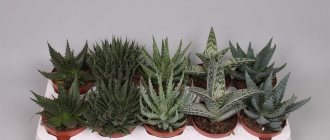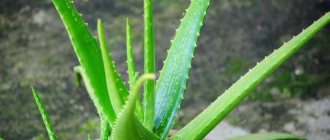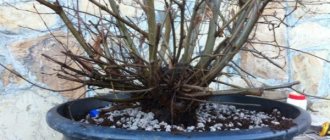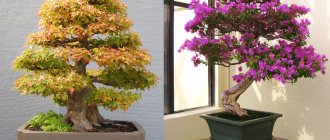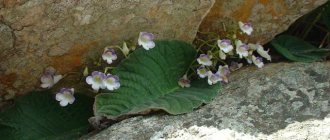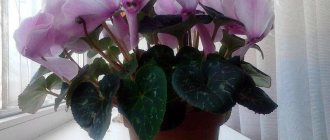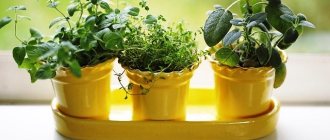Housewives love aloe vera for its unpretentiousness combined with a lot of useful properties.
However, there are some rules of care that must be followed in order to always have a reliable assistant at hand for many health problems. Below we will find out what you need to know before bringing this South African guest into your home.
general description
This perennial tropical plant with the mysterious name aloe arborescens “nomaded” to us from Southern Africa. There it grows among the wild nature.
As a wild plant, it can be found in the vastness of Zimbabwe and Mozambique.
There it often grows up to 3 meters in height .
In our latitudes it is used for medicinal purposes and simply as an ornamental houseplant.
It is no coincidence that it is called Aloe tree. In appearance, the plant really resembles a small tree with dense and low branches. It has a short straight trunk and smooth, large, spiky, sword-shaped leaves at the edges. The leaves are juicy and fleshy. Look at the photo to see what the plant looks like.
Beautiful inflorescences with bell-shaped flowers periodically form at the top. But it blooms at home extremely rarely.
Aloe Vera
Like Scarlet Tree, it has medicinal properties. It is distinguished by fleshy leaves with a high water content (97%). The leaves have pale white patches. The composition of this species is very rich in minerals, amino acids, enzymes and beta-carotene. Actively used in cosmetology and medicine. In care, a moderate watering regime should be observed.
Read more about Aloe Vera care and healing properties.
Aloe and agave: what is the difference
When it comes to aloe, you've probably heard that some people call it something else - agave. Many people are interested in the question: what is the difference? Aloe vera is popularly “christened” as Agave .
There is an opinion that you are lucky enough to see flowers on this plant only once every hundred years. Whether this is actually true is difficult to say. But blooming aloe in our home is an extremely rare occurrence.
This name applies only to aloe vera. , about 400 species of aloe are known to science . On our windowsills there are usually 2 types of South African guests - agave or aloe vera and aloe vera (sometimes considered agave).
These two species differ from each other only in appearance: agave has a trunk from which sword-shaped long fleshy leaves diverge, and aloe vera looks like a bush.
So we can say that aloe and agave are the same plant. With only one small clarification - we are talking about aloe vera.
Contraindications
When used internally or externally, agave and other medicinal types of aloe have no special contraindications. However, in the case of using this plant as a laxative, it should be noted that taking it in high doses can disrupt intestinal motility, causing inflammatory processes in the large intestine.
For this reason, it is strongly recommended not to take drugs based on agave as a laxative for people suffering from uterine or hemorrhoidal bleeding. Another prerequisite for a contraindication to the use of the drug is pregnancy .
We invite you to watch a video about contraindications to the use of aloe:
Lighting
Aloe is one of those indoor plants that love light.
So choose the brightest possible place for it in your home .
In addition, it is necessary to often turn the plant towards the light - twist it in one direction or the other.
Otherwise the trunk will bend.
Important! In the warm season, if possible, keep aloe outdoors (on the balcony or in the garden). Just take care of protection from rain.
Interesting Facts
This plant is not only elegant and beautiful, it brings great benefits. In the room where the flower is located, the air is purified, it becomes much easier to breathe, and the health of the inhabitants of the house improves, troubles and sorrows recede.
Aloe is able to protect the residents of the apartment where it grows from failures, troubles and ailments. If a sick person hangs agave leaves around his neck in a bag, the disease will soon recede. The flower is believed to attract love. A girl who wants to get married quickly can speed up what she wants by performing the following ritual:
- it is necessary to carefully cut 13 leaves from the plant, after asking its forgiveness;
- the leaves are placed in a dark, dry place for 13 days;
- They burn dry leaves and scatter the ashes near the threshold of their apartment.
Having completed the ritual, there is no doubt about the speedy result.
Watering, humidity
Even in summer, aloe does not need much water. Watering should be moderate . The optimal frequency is once a week. In winter, on the contrary, rare watering will be enough.
In general, the plant is very sensitive to waterlogging. If water stagnates in the pot, the roots may fester and the aloe will die.
Important! Aloe is drought-tolerant (in winter it can be safely placed next to the radiator). Moderate watering is one of the main criteria for proper care.
How to determine if a plant has enough water? When watering, pay attention to the presence of moisture on the tray. If the moisture has settled, it means there is enough water. Pour it out and stop watering.
Using the flower tip
Using the top of an aloe for propagation causes injury to the plant, but it is often used to rejuvenate an aged flower and if its lower leaves and side shoots have already been cut off. This method is simple and easy to perform and leads to rapid rooting of the apical process.
It is carried out as follows:
- the top must be trimmed so that it has at least 7 leaves;
- the cut off top is dipped cut into a solution of phytohormone growth or other root growth stimulator and kept for 30 minutes;
- then the treated shoot is placed in a glass container with warm (but not hot) water;
- soon the first roots appear, and after they reach 6 cm, the rooted top is planted in the soil in a separate bowl.
The top should only be cut off with a clean, sterile instrument, since the slightest contamination can cause an infection in the flower. Some gardeners advise, after cutting the top, to keep the shoot for several days in a dark room until a protective film forms, and only then put the top in water.
Soil and fertilizing
Add charcoal and brick chips to the soil where aloe will grow.
Or buy a substrate.
Fertilizing with mineral fertilizers is carried out 2-3 times a year and only in summer.
You can use fertilizer intended for cactus plants. It is recommended to apply it to moist soil once every 3-4 weeks. Fertilization should begin in April and continue until the end of September.
Important! Aloe is not suitable for soil that is too nutritious. Do not overuse fertilizing.
How to replant
It is recommended to replant an adult plant once every 2 years, a young one - once a year. The most favorable time is spring. A drainage layer (5 cm) must be placed on the bottom. For replanting, take a ceramic pot and soil “For cacti and succulents”. You can prepare the soil yourself by taking 4 parts universal soil and 1 part coarse sand.
So, let's imagine that we already have a pot of soil and the plant is ready for planting. Now we perform the transplant in the following sequence:
- Pre-moisten the soil.
- Make a recess.
- Add some sand there.
- Insert plant.
- Sprinkle with sand and soil.
- To provide stability, it is advisable to place pegs.
- Cover the transplanted aloe with a plastic bag, leaving room for air underneath.
- Place the pot on a windowsill where there is more sun.
- When young leaves appear, remove the bag.
At this point, the transplant process can be considered complete. The branches have young leaves - this means that the aloe has taken root.
Reproduction
There are two known methods of breeding aloe - vegetative (cuttings) and seeds.
Cuttings are a faster way. In spring or early summer, a shoot is separated from an adult plant. The cut can be treated with Kornevin to stimulate root growth, sprinkled with activated carbon. Planted in prepared soil, usually a mixture of leaf and turf humus and sand. Water generously.
Seeds are sown in February in a well-drained, moist sandy mixture. They don't go deep. Cover with glass or film. It should be ventilated every day to prevent condensation from accumulating. When seedlings appear, the glass or film is removed. The temperature should be maintained at about 20⁰С. As soon as the first leaves appear, young plants can be replanted.
How does it reproduce
Agave propagates by root shoots and cuttings .
Usually we grow a large number of shoots that already have their own root system.
You just need to pick them up and replant them.
This is the easiest way to reproduce.
As for the cuttings, before planting they are dried for 2-3 days in the air . Replant into 1 cm of sandy soil. Ordinary sand or sand mixed with peat is suitable for this.
Water very carefully, otherwise the cutting may simply rot. Transplant into pots 2 weeks after the roots appear.
Medicinal properties
For medicinal purposes, the leaves are used, which are cut off at the very base, as well as the juice squeezed from them. The juice has a bitter taste and unpleasant odor. Has a bactericidal effect. That is why aloe is so often used in traditional and folk medicine.
The scope of application is very wide. The plant can help with many ailments:
- wounds and burns;
- loss of strength;
- decreased immunity;
- sexual impotence;
- colds and bronchitis;
- indigestion;
- genitourinary infections;
- eye diseases, etc.
On the shelves of pharmacies there are a lot of drugs that contain aloe vera. Liquid aloe extract for oral administration, as well as a solution for injection, are sold separately.
The medicinal properties of agave will increase if you leave it without watering for 2 weeks . Another way is to cut off a leaf and put it in the freezer for 10 days.
Chemical composition
Chemical composition. Fresh leaves and juice of the plant contain enzymes, vitamins, and phytoncides. The following have been isolated from aloe leaves: aloin, nataloin, rabarberone, homonataloin, emodin, resinous substances and traces of essential oils.
The leaves contain: ash - 17.68%; macroelements (mg/g): K - 28.5, Ca -79.1, Md - 17.4, Fe - 0.32; microelements (CBN): Mn - 0.38, Cu - 1.10, Zn - 2.75, Co - 0.04, Cr - 0.08, A1
- - 0.09, Ba - 14.90, Se - 11.90, Ni - 0.45, Sr - 17.64, Pb - 0.22, I
- - 0.10, Li - 162.00. B - 94.00 mcg/g. Mo, Cd, V, Au, Br were not detected. Concentrates Ca, Mg, Cu, Zn, Se, Li, Ba, especially Ca, Zn, Se, Li. Can accumulate Mn, Cu.
Active ingredients
Fresh leaves and juice contain anthraglycosides - aloin, nataloin, rabarberone, emodin, resinous substances and traces of essential oils. They contain small amounts of enzymes, vitamins and phytoncides.
